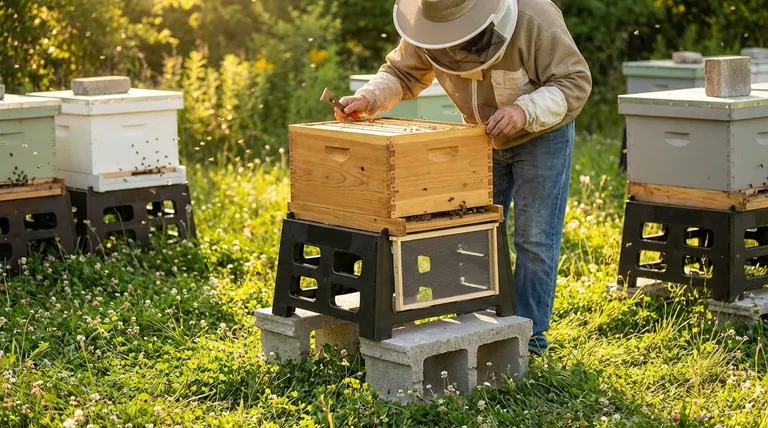In short, yes. Using a beehive stand is a fundamental practice that provides significant benefits for the health of your honey bee colony and the efficiency of your work as a beekeeper. Elevating your hive improves ventilation, protects it from moisture and pests, and provides easier access for inspections and maintenance.
A hive stand is not merely a platform; it is a strategic tool that separates your colony from ground-level threats. This simple elevation is one of the most effective investments you can make in the long-term health of your bees and the longevity of your equipment.

Protecting Your Colony's Health
Elevating a hive directly addresses several environmental threats that can weaken or destroy a colony. A stand creates a crucial buffer between the hive and the ground.
Reducing Moisture and Rot
Hives placed directly on the ground absorb moisture, leading to a damp internal environment. This dampness promotes mold and mildew, stresses the bees, and quickly rots the wooden bottom board of the hive.
By lifting the hive even a few inches, you break this contact with the wet ground. This simple act drastically extends the life of your equipment and helps the bees maintain a healthier, drier internal climate.
Improving Airflow and Ventilation
Elevation improves air circulation around and under the entire hive. This is especially critical for hives equipped with a screened bottom board.
Proper airflow helps the colony regulate its internal temperature more efficiently during hot summers. In the winter, it helps vent excess moisture, preventing condensation from dripping down on the cluster of bees.
Deterring Pests and Predators
A stand creates a physical barrier against ground-dwelling pests like ants, which can be a nuisance to a colony. It also makes the hive a less convenient target for predators like skunks, which disturb the bees by scratching at the entrance.
Making Beekeeping More Efficient
A well-chosen hive stand doesn't just benefit the bees; it makes the physical work of beekeeping far more manageable.
Easing Strain on Your Body
Beekeeping involves lifting heavy boxes filled with bees, brood, and honey. Bending over to inspect a hive on the ground puts significant strain on your back.
A stand raises the hive to a comfortable working height, reducing the need to bend and stoop. This ergonomic benefit is one of the most appreciated aspects of a hive stand, especially as your apiary grows.
Maintaining Clear Entrances
Grass and weeds can quickly grow up and block the hive entrance, impeding the flow of foraging bees. This forces guard bees to spend energy clearing the entrance instead of defending the colony.
Elevating the hive ensures the entrance remains clear, allowing for unobstructed flight paths and reducing stress on the colony.
Understanding the Trade-offs
While the benefits are clear, it's important to consider the practical implications of using a hive stand.
The Risk of Instability
The higher you raise a hive, the less stable it can become. A tall, narrow stand on uneven ground or in a high-wind area poses a risk of tipping over, which would be catastrophic for the colony.
Ensure your stand is level, wide, and securely placed. In windy locations, you may need to strap the hive to the stand for added security.
The Initial Cost and Setup
Hive stands are an additional piece of equipment that represents an upfront cost and setup time. While commercial options are available, many beekeepers opt for simple, DIY solutions like stacked cinder blocks or wooden pallets.
While a dedicated stand may cost more, it often provides better stability and ergonomic height than improvised solutions.
Choosing the Right Stand for Your Apiary
The decision to use a stand is straightforward, but the type of stand depends on your specific goals.
- If your primary focus is colony health: Choose any stable option that elevates the hive at least 6-8 inches to ensure protection from ground moisture and pests.
- If your primary focus is beekeeper comfort: Select a stand that raises the hive's bottom box to a height that minimizes bending for you, typically around 18 inches.
- If your primary focus is budget and simplicity: Use sturdy, level cinder blocks or untreated wooden pallets, but remain mindful of their potential instability compared to a purpose-built stand.
Ultimately, elevating your beehive is a foundational step toward responsible and sustainable beekeeping.
Summary Table:
| Benefit | Key Impact |
|---|---|
| Colony Health | Reduces moisture/rot, deters pests, improves ventilation |
| Beekeeper Efficiency | Eases back strain, keeps entrances clear, simplifies inspections |
| Equipment Longevity | Protects woodenware from ground contact, extending its life |
Ready to protect your investment and simplify your beekeeping?
HONESTBEE supplies durable, commercial-grade beehive stands and apiary equipment to commercial apiaries and distributors. Our wholesale-focused operations ensure you get the reliable, ergonomic solutions your business needs to keep colonies thriving and operations efficient.
Contact HONESTBEE today to discuss your apiary's needs and request a wholesale quote!
Visual Guide

Related Products
- Plastic Bee Hive Stand for Beekeeping
- Metal Hive Feet Bee Hive Stand for Ant Protection
- Metal Bee Hive Stand Bee Box Stand for Beekeeping
- Wholesales Dadant Size Wooden Bee Hives for Beekeeping
- Professional Drop-Style Hive Handles for Beekeeping
People Also Ask
- How do bees regulate ventilation and temperature in the hive? Master Hive Climate Control
- Why is elevating the hive important? A Simple Step for a Healthier, More Productive Colony
- What is the purpose of a hive stand in a Langstroth hive? Protect Your Hive and Boost Colony Health
- What are the main differences between Langstroth and Top Bar Hive designs? Choose the Right Hive for Your Beekeeping Goals
- What are the advantages of polystyrene hives for beekeeping? Boost Colony Health & Honey Yields



















